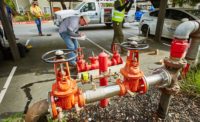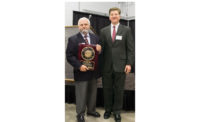
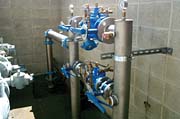
Contaminated water is like a ravenous lion. We've chained it heavily and watch safely at a distance. For the most part, technology, technique and testing keep the "lion"
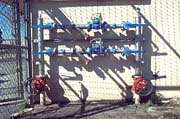
The Good, the Bad and the Ugly"
Is the risk real? Should the possibility of contamination be taken seriously?Consider the case of a plywood mill in Oregon from several years ago. After a week in which a large number of employees stayed home from work with similar complaints of nausea and severe diarrhea, the county health department was called in to test the drinking water supply. It was quickly discovered that fecal coliform was present in unusually high levels.
As the health department looked for clues, it was found that-though the mill's water came from the city supply and appeared to be clean, and with the proper levels of chlorine-the mill also drew water from an adjacent river to supply its fire system. Booster pumps maintained fire system pressure at about 125 psi. The water from the city entered the mill at about 70 psi.
The mill's maintenance staff examined the piping system for cross-connections, and indeed, three were found (with open gate valves) between the fire and potable water systems. The mill's recent use of water had been unusually low-10 cubic feet per month, instead of the 7,000 to 9,000 cubic feet used by comparable mills. Mill employees had been drinking untreated river water via cross-connection.
A single check valve was located at the mill's connection to the city. It's assumed that this prevented further contamination. No doubt, without it, the mill would have supplied more of the contaminated water into the city's mains.
And, this from the American Water Works Association "Summary of Backflow Incidents,"
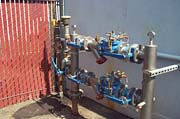
So where are the weak links in the chain? Inconsistent accountability to agencies of jurisdiction. Insufficient training of testing personnel and-too often-lack of experience when handling anything out of the ordinary. Loose requirements for testing procedures. And a cross-connection control (CCC) policy without specific needs or demands for the water company above minimum standards, permitting far too much flexibility.
The answer to all of these problems, really, is for water companies to set a baseline for performance and verification and to enforce them. We should insist on:
- A policy or guidance document that verifies the tester's presence and establishes that all components are functioning properly, and as designed.
- A pressure reading.
- A main water meter reading.
- The time of day.
We should force accountability and not permit arbitrary, voluntary verification of backflow testing.
That's why I feel testing protocol should be more rigorous and verifiable, and that the CCC programs be much more dynamic and designed around the specific needs of each application, unique need, and water department. Also, that testing personnel be more thoroughly trained and more experience be gained before they "go solo"
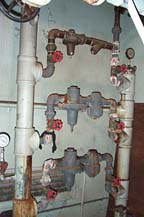
What's To Be Done? Where to Begin?
The test form polices the CCC program.Water pressureis a very important factor and should be noted on the form. These key facets apply:
- a) In some areas, water pressure can be excessively high. This places a lot of stress on the backflow device, and, by the way, negates a manufacturer's warranty.
b) The customer should be informed if the pressure is regulated or not. The pressure regulator is a key component of safety to the water piping system.
The tester must come in contact with the valve to get the pressure reading, and the data must be recorded that verifies this.
Requiring a water meter reading forces intelligent contact with the backflow assembly. The tester must verify what water meter he is shutting off prior to the test. The water meter reading also helps to police the program because:
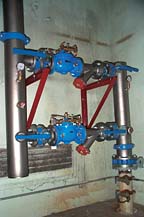
Flooded With Risk
Consider this recent legal case in Southern California. While working in a medical facility, a plumbing contractor had turned off the water main for a short time. He was unaware that nurses had partially closed the supply valve to a vacuum breaker, starving flow to the backflow assembly. The unit leaked, undetected, for days. It flooded three floors of the building, effectively closing six doctor's offices for six months. A substantial lawsuit followed.I ask: why are we shutting down water service, especially to buildings where water service is critical, such as restaurants, hospitals, schools and clinical facilities? It's not necessary. Designers and engineers need to know there's a better way. The regulator doesn't need to go into the building; put it with the backflow preventer. This lets the water customer have uniform pressure at the needed flow rate.
Accomplishing this has never been easier. The dual backflow assembly, regulator and other components-if combined in one, fully redundant valve station-eliminate the following:
- 1. The need to provide a designated room for the components.
2. Mainline with 24 hours of high pressure on it going to various buildings containing their own set of regulators inside. This reduces the pressure at the BFA, and in turn, reduces the high pressure in the mainline throughout the facility.
3. The use of the Automatic Control Valve (ACV) for regulating of pressure to facilities is the best way to optimize the pressure range. The ACV has a higher range of pressure and can hold design operation pressure consistently when more gpm is needed.
4. The redundant use of several direct-acting regulators in parallel to get the optimal flow range. One ACV will hold the design pressure when flowing of more gpm is called for. The Direct Acting (DA) regulator will lower pressure as more gpm is called for.
5. The need for a regulator in the irrigation system. Pressure is generally adequate because the flow pressure drop is not there.
6. The backflow tester can test the backflow assembly without interrupting water flow to the building, have the time to quality repairs, and if necessary, change station components with no interruption in service or regulated pressure.
Generally, the design is to meet backflow requirements-a 3"
Concepts Applied
Here's one application in California where we put our concepts to good use. Two years ago, we were called to fix a problem at an upscale Rancho Mirage, CA, condo development.
At "Desert Island,"
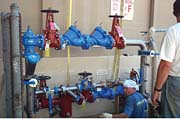
Backflow's Undercurrent-It's a Coast-to-Coast Problem
Here in Central Pennsylvania, I test a lot of backflow assemblies. And, yes, many in the industry would quickly affirm it: we have a national problem today that's created by testing firms that have a hankering for shortcuts. The risks are many, even catastrophic, yet the allure of easy money and less-than-honest testing is just too strong for some testing firms, or individuals. It's too bad that their actions have made it tougher for most of us in the business of backflow testing that want nothing more than to do the job well. Most of us share the opinion that lives and enterprises are at stake, and our job is to provide a safe water supply for all facets of life. If water companies would embrace Bernie's concepts and develop testing programs that take away all of the uncertainties with verifiable procedures that provide strong data and information, we'd set a new standard for the industry. It's a win-win for everyone.A recent event illustrates why I agree so strongly with what Bernie Clarke is saying. Just a few weeks ago, a factory that I visited on a Saturday-chosen to minimize disruption of service to a large printing company-stated that their BFP was in a meter vault by the road. Upon first inspection, all that existed in the pit was a meter and an old-style bronze swing check nontestable device. I called in the head of maintenance. He was adamant that the previous testing company had always sent two people to do the job (due to confined space entry), and he led me to the same manhole. "No dice,"
